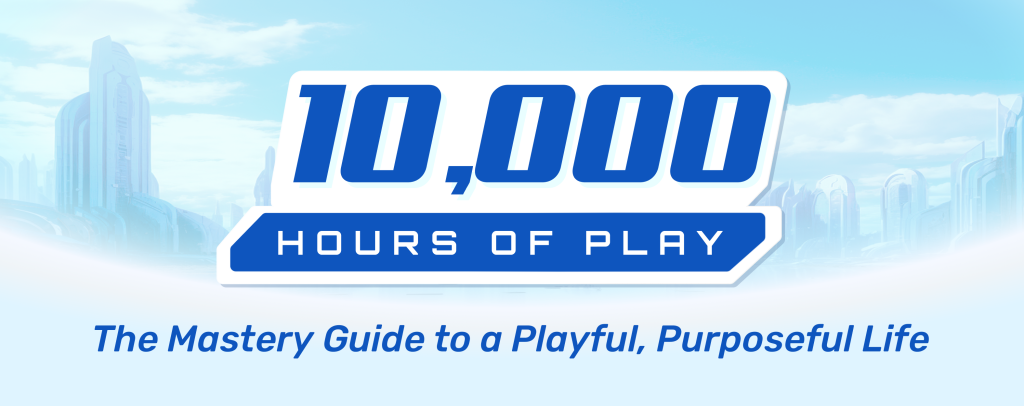
10K HP Step 4: Enhance Your Abilities (Skill Sets)
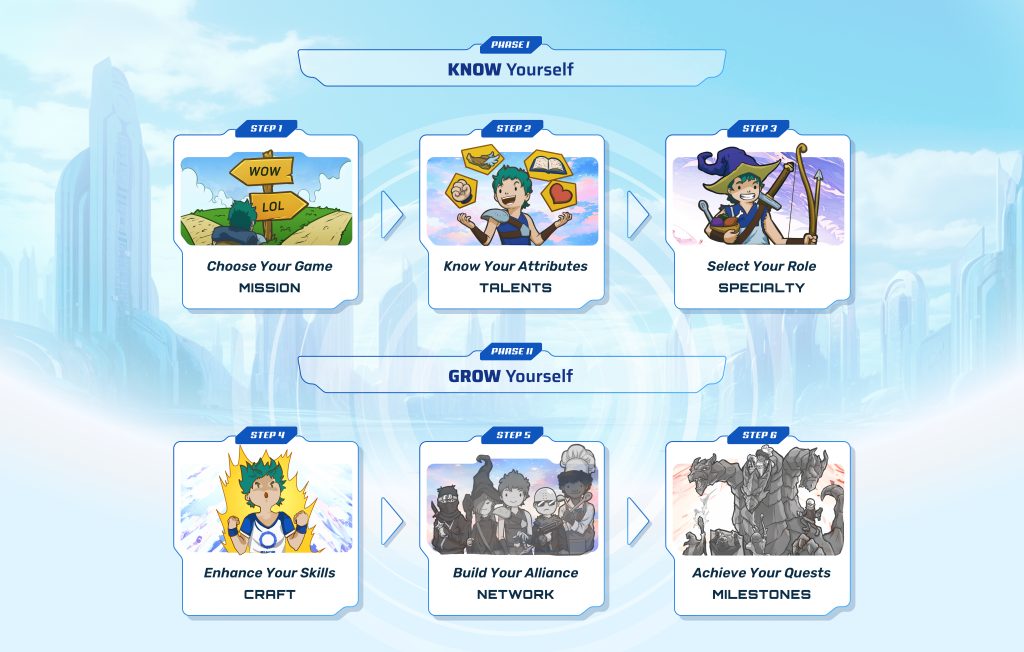
One of my favorite games as a kid in the ’90s was Dragon Ball GT Final Bout (DBGT). Although it received horrible reviews from critics, it developed a cult following of crazed Dragon Ball fans starving for a video game.
In many ways, the game was a standard fighting game, but unlike Street Fighter and Mortal Kombat, DBGT had a unique Build Up Mode that allowed players to train their fighter, increase in level and skill, and then use it in Battle Mode against friends to see who had built the strongest character.
My friends would level up all of their character’s abilities equally to have a well-rounded fighter. I on the other hand figured out a trick: I just leveled up one skill over and over again until it was so overpowered (OP) that I could destroy my opponents in just one hit.
In the game of life, you too must enhance your Skills. However, it’s not as simple as just becoming OP in one Skill. Often times you’ll need to enhance multiple, Synergistic Skills in order to beat your GAME.
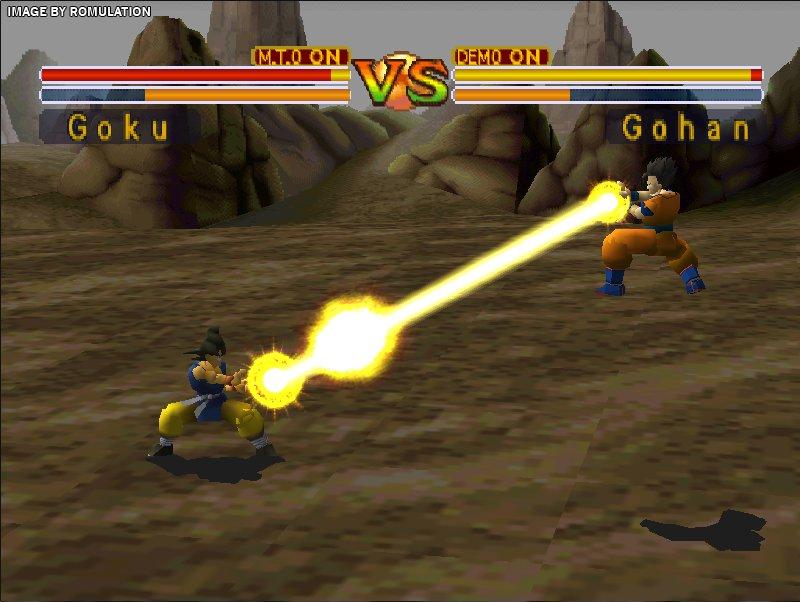 Dragon Ball GT Final Bout
Dragon Ball GT Final BoutJack of all trades, master of none
Should you focus on being world-class at only one Skill or should you try to develop as many Skills as possible? The answer of course, is not to focus on one extreme over another; but rather, to focus on a few Synergistic Skills.
In the Skill Spectrum, if you’re too far to the left, then you’ve become a Specialist — someone that excels in a very limited scope. For example, in Chess, you may be an absolute master in the King’s Gambit opening; however, if your opponent doesn’t let you go into the King’s Gambit opening, or you simply move into the middle game or endgame where you are very weak, then you will be out of your element and lose the game.
If you’re too far to the right, then you’ve become a Dabbler — someone that develops Skills in many areas, but that never truly masters any of them. To keep with the Chess example, you may develop Skills in openings, endgame, writing (to write a chess book), design (to create your chess logo), speaking (for your book tour), negotiation (to get better rates when you travel to chess tournaments), fashion (to look good while playing chess), and many other Skills. These Skills surely are synergistic if your ROLE is to become an established Chess Author or Journalist, but if your role is to become the strongest chess player, then most of these skills are unrelated and distracting towards your true goal of being a chess master.
To beat the game of Chess, you must master a few Synergistic Skills. Magnus Carlsen is the best Chess player in the world because he has mastered Skills in chess openings, positioning, pawn structures, endgames, exchange sacrifices, dark/light color plays, and many more far beyond other players.
Of course, Carlsen’s strong ATTRIBUTES of concentration, memorization, pattern recognition, and mental endurance allow him to become the best in the world at what he does. Carlsen regularly practices the Skill of meditation to enhance these Attributes.
The second Chess World Champion Emanuel Lasker, who was a psychologist, decided that understanding human psychology in chess was synergistic to his raw chess Skills. He was known to often play the second best move instead of the best, because he knew his opponents would be more uncomfortable with the position and play poorly.
With his Synergistic Skills, Lasker was World Champion for 28 years (1894 to 1921) and is also considered the strongest 67-year old in Chess History.
Synergistic skills

In the classic RPG Final Fantasy VII, players discover and earn Materia to enhance the Skills of their characters. For example, the Fire Materia allows players to cast fire spells on enemies to deal damage.
In addition, Materia Combos allow players to link two Materia together to create a Synergistic Skill: link “Cure” with “All” and you heal all of your characters on the screen.
It was incredibly fun to collect Materia and experiment with them to discover the best combination of Synergistic Skills (this is also a great example of Core Drive 3: Empowerment of Creativity & Feedback in the Octalysis Framework):
- Mug + Steal = deal damage while stealing items
- Magic Counter + Cure = heal when attacked
- Final Attack + Phoenix = revive everyone at max health upon death
In the game of life, you too must discover and develop Synergistic Skills to beat your Game. Some important notes about enhancing your Skills:
- You’re not born with Skills. Skills must be learned and enhanced through education, training, and hard work. For example, an online marketer must learn SEO – Search Engine Optimization (they’re not born with SEO knowledge).
- The amount of work needed to achieve mastery depends on your Attributes. For example, if you’re enhancing your Skill in conversion optimization, it is helpful to have the “Empathy” Attribute, allowing you to better understand your audience and to fulfill their needs through the right emotional triggers.
- Time is your most precious asset. Be conscious of the opportunity cost of developing one Skill over another. Every hour you are improving one Skill means you are not improving another.
It’s important to plan ahead so that your Skills aren’t wasted. You don’t want to find yourself in a situation where you’ve invested three years learning a new language only to be in a career where your new language Skill would never be used (this Skill would then just be a costly hobby).
By planning ahead, you can map what Skills you’ll need to beat your Game, improving your chances of obtaining and enhancing relevant and Synergistic Skills.
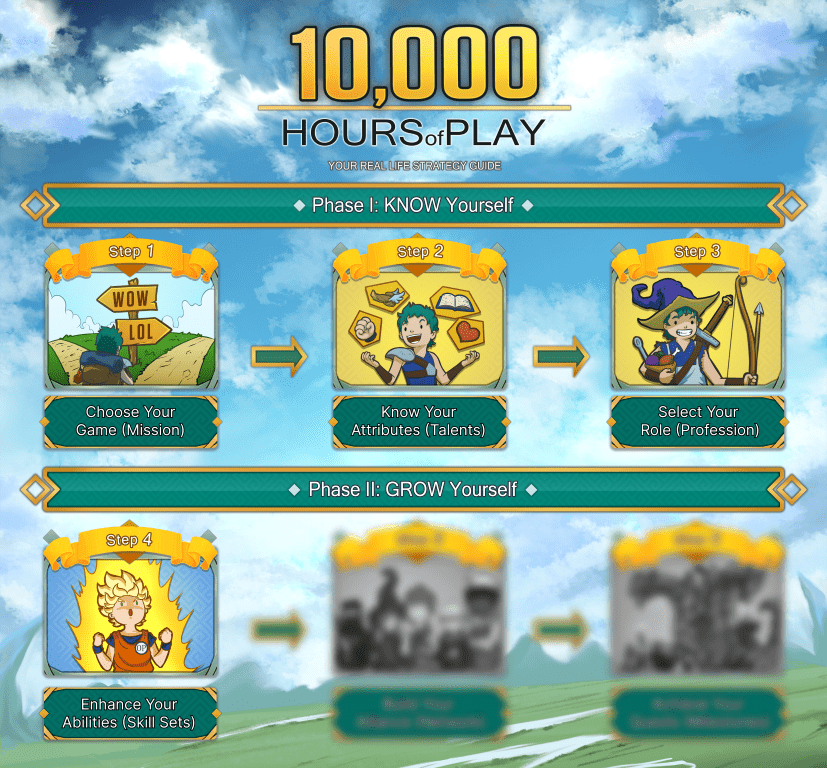
How to enhance your Skills
Step 1: Map your current Skills
The first step is to create a map of your current Skills. It’s not enough to simply list out your Skills; rather, this exercise is about respecting and acknowledging the process and dedication it took to obtain your Skills.
To make the map, write down your chronological experience map:
- Games you have mastered
- Networks you have built
- Clubs or organization to which you have contributed
- Books or blogs you have consumed
- Training and learnings that have enriched your knowledge
- Experience through work

Keep this map close as we will later reuse it as your “Quests”.
Write/Print out your experience and start making notes about the Skills you gained. Don’t worry about being to broad or too specific; it’s important to just write down your Skills and only later rank and refine them.
Some examples of Skills are: debate, strategic planning, sprinting, brainstorming, programming, social media marketing, photo-shop, plumbing, laughing wholeheartedly, meditation, interviewing, financial engineering, planning schedules, comforting others, carrying heavy objects, playing the piano, Spanish, Gamification design, public speaking, you get the idea.
Step 2: Rank your Skills
Now that you’ve listed your Skills, it’s time to rank them: from strongest to weakest. You don’t need to be completely precise, but it would be helpful to get close to reality as we will use this information to make some growth decisions later on.
There are two main ways to rank your Skills:
- Compare them to your other Skills.
- Compare them to other people who have this Skill
Compare them to your other Skills
Comparing one Skill to another can be an easy way to rank your Skills. For example, before attending UCLA, Yu-kai’s Chinese Skill was much stronger than his English Skill; however, after graduating UCLA and starting companies in the US, his English Skill surpassed his Chinese Skill. He has also spent more time learning and honing his chess Skill rather than practicing the violin, so it is fairly easy for him to tell that his Chess skills are greater.
Sometimes there are things that are a bit more difficult to compare, such as leadership Skills verses communication Skills since we often develop these skills passively through various activities (you wouldn’t say, “I was leading 3 hours a day and then I communicated for 2 hours afterwards so I increased my leading skills more”).
To rank these types of Skills, ask yourself the following question:
If I had an organization and was looking to hire myself as a full-time employee, what Skills would I hire myself for?
- Would I hire myself to play the violin?
- Would I hire myself to lead the organization?
- Or would I hire myself to communicate with the public?
Compare them to other people who have this Skill
The best (and most rewarding) way to rank your Skills is to compare them to other people. Similarly to your Talents, this is where you explore previous accomplishments, recognitions, and victories: were you in a varsity sport in High School? Did you score well in a design competition? Were you making all of your friends look bad in karaoke?
Picking the right group
Of course, you want to pick the group you are comparing with carefully. Are your coding skills just considered excellent compared to your friends who study the social sciences? Or are you actually the person solving all the problems in your technology company?
Generally, pick a group where you are competitive in to build confidence in if you are already certain of your path forward. It also generates the most amount of opportunities because you shine the most.
But if you are determining what you are good at, it’s better to be in a group where there are many people who are excellent at it, which would then push you to catch up and compete with the people that have mastered the Skill.
Focus on the big picture
Don’t get stressed over the minute details of placing one Skill greater than another. As long as these Skills are in the same ball park, your ranking will help you understand the Skills you have obtained for later analysis on synergy and how it connects to your game. These orders change all the time anyway as we grow and learn more about ourselves.
Now that you have a prioritized list of Skills, it’s time to create your (current) Skills Triangle.
Step 3: Create your Skill Triangle

Once you have determined your skills and a rough ranking, you can now create a your own Current Skill Triangle. Similar to your Talent Triangle, it lists a few top skills on the top, and then a few strong ones in the middle, and then the weakest but still competent skills on the bottom.
The above example is Yu-kai Chou’s Skill Triangle in 2008. During that time, Yu-kai observed that his top three skills being Coaching, Networking, and Leadership.
What do they all have in common?
They all deal with people, and utilizes his high Empathetic Intelligence, Trustful Sincerity, and Optimism Attributes.
Very often our top skills are a build-up and utilization of our attributes, just like attributes such as running fast and jumping high likely will lead to high skills in various sports.
Yu-kai also felt that at that time he had fairly strong innovation abilities, based on his years of startup experience powered by his Associative Thinking Attribute. Growing up in South Africa, Taiwan, and the US also gave him high proficiency in being bilingual in Chinese and English.
His years in startups also helped him understand Gamification, Social Media, and Branding better than most people out there. Finally, there are some technical things that he picked up along the way, from recruiting talent, sustainability knowledge (he was very involved in the California Student Sustainability Coalition), and other skills such as data analysis and photoshop.
His life experiences all contributed heavily to his skills, but whether or not these are relevant for his Game and Role is not guaranteed. This particular set of Skill Triangle would be great if Yu-kai wanted to be a one-on-one coach, who gets business by networking and social media branding, and uses gamification to make coaching more fun.
However, Yu-kai’s Game and Role evolved into transforming peoples’ lives at scale through a scalable and gamified platform (Octalysis Prime), and therefore his skills in 2008 will not be what it takes to be successful in his Game and Role. We will talk about that later.
Remember: Skills are not utilized in a vacuum; the combination of Synergistic Skills and Attributes can make you stand out and help you beat your Game.
For example, you and a rival are competing to create innovative products that help parents educate their children. Although your rival may have an incredibly strong Innovation Skill, you can ultimately come out the stronger player because of your combination of Innovation, Branding, Promotion Skills alongside your Perseverance Attribute.
So don’t feel discouraged if someone at your work or in your classroom has a stronger Skill than you; if you train Synergistic Skills that compliment your Attributes, then your Skills will compound and you’ll be a stronger player.
Step 4: Identify what skills you need to develop to beat your Game
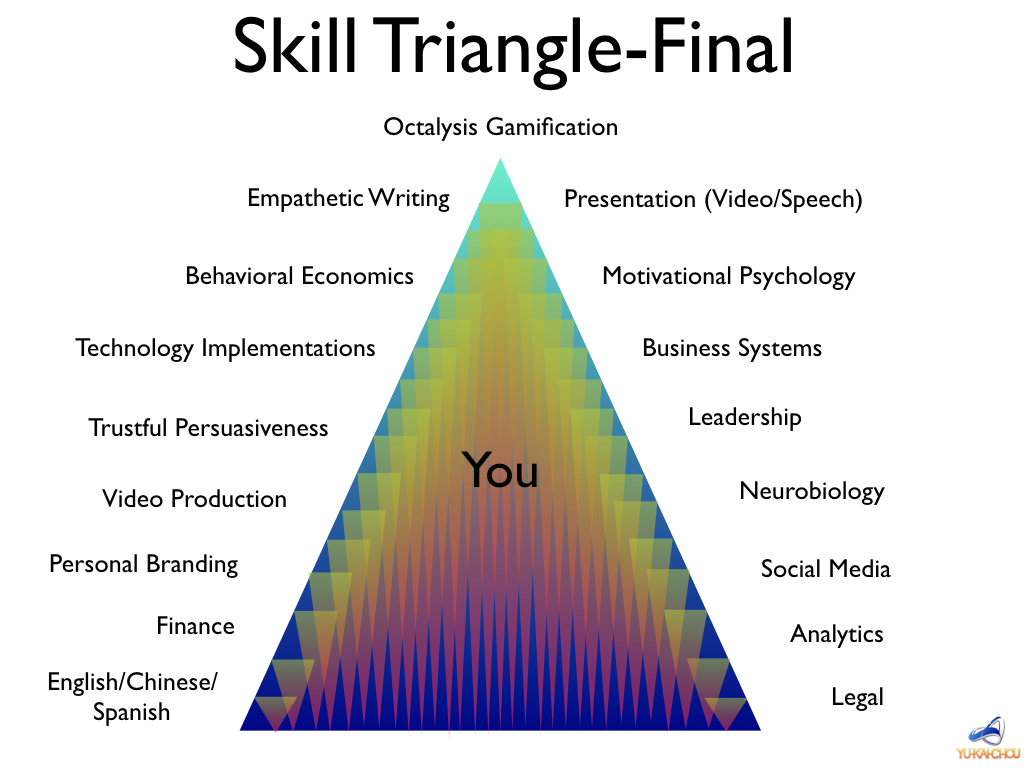
From the previous steps, you’ve Chosen Your Game and Selected Your Role. You’ll now use these to identify the Skills you need to develop. This is where the Target Skill Triangle comes in.
The Target Skill Triangle is a visual representation of what your top Skills should be in order to become the strongest Role in your Game. In order to figure out your Skill Triangle (Final), you must imagine the Top Master at what you want to do (your Role), and what Skills they are good at.
Occasionally that Top Master already exists, and you just have to study closely what skills they have mastered.
If your role is to become a great Visionary Product Leader, you can look at Steve Jobs or Elon Musk and see that they have the following skills: persuasion, innovation, design, user experience, branding, marketing, leadership, execution.
Therefore, you can create a Target Talent Triangle that mimics that of Steve Jobs and/or Elon Musk.
In the above, you can see Yu-kai’s Target Skill Triangle, where it is optimized to be a thought leader in behavioral design and gamification, while sharing all his knowledge on a gamified education platform such as Octalysis Prime. This is where Yu-kai wants to be in 2008 as a top player in his game.
You can see that the top skills now focus on being the greatest at Octalysis Gamification (which makes sense since Yu-kai is the creator of that school of design), but empathetic writing and presentation skills (both video and speech) become on top. Yu-kai needs to present his ideas in compelling ways to truly transform the masses.
Below that we see some skills that are important to power his trade skills or running his business – motivation psychology, business systems, video production, personal branding, and finance.
Curiously, while Mandarin/English bilingual was positioned quite highly in Yu-kai’s example Current Skill Triangle, Yu-kai’s example Target Skill Triangle shows Mandarin/English/Spanish trilingual low on the chart.
This means that Yu-kai’s bilingual skill in Mandarin and English was much higher than most others who were also bilingual in Mandarin and English (Yu-kai published a 500-page book in English and also wrote a Chinese novel that is twice the size). However, Yu-kai wants to be trilingual with Spanish as his third language. But being trilingual would not make it to his 2008 Current Skill Triangle because he completely sucked at Spanish (and still does right now).
But in the Target Skill Triangle, Yu-kai puts Trilingual with Mandarin/English/Spanish as one of his aspired skills, but generally it would be low impact for his role and success, so it has been moved down the triangle to be less impactful for his particular game and role (which justifies why he still sucks at Spanish right now).
By following the path of masters and identifying what allowed them to become top in their game, we can begin to identify what our Target Skill Triangle looks like.
Once we have identified the Target Skill Triangle , we can compare it to the Current Skill Triangle and start to make a plan on the skills we need to acquire to become better at our Game. This is where QUESTS come in.
For instance, if you decide that your Target Skill Triangle should be similar to Yu-kai’s (perhaps you want to play a similar Role in a similar Game), you would also first need to master Octalysis Gamification, which means you would need to read up, practice, and apply as much Octalysis Gamification knowledge as possible (Octalysis Prime might look like a good option).
But you would also need to improve your empathetic writing and presentation skills. You could go to your local Toastmasters to improve your skills in public speaking, study many great video bloggers and see what techniques they use, and find someone who is good at empathetic writing to improve and optimize your emails.
We will discuss Quests in detail in a future post. Quests are what ties everything in 10K HP together as it is about how we choose to live our lives like a game that will make the biggest difference.
I still have no idea where to start
For some people identifying their Target Skill Triangle is quite difficult and the paths to mastery is far beyond their current grasp.
Don’t be intimidated. A simple way to get on the right path is to find job postings of similar Roles to identify the Skills they value. In this way, we can start small and as we begin to master the Game we can eventually grow and upgrade both our Current and Target Skill Triangles.
Look up job postings for your Role
Let’s say you want to play the Role of a UX (User Experience) Designer. A simple Google search online shows that the following companies value the following Skills for their UX Designers:
Role: UX Designer
- Airbnb
- Excellent communication skills
- Lo-fi & hi-fi prototyping skills
- Strong collaborator with product managers and engineers
- Have shipped product
- Have cross-platform design experiences (Web, android, iOS, emails)
- Apple
- Experience in delivering wireframes, UX flows, mockups, interactive prototypes, personas and use case development is required.
- Ability and passion to understand distinct user groups quickly and distill complex needs into clean, understandable solutions.
- Understanding of information architecture, design patterns and interaction design.
- Work as part of a cross functional team, with users, product owners, business analysts and development teams to deliver business value.
- Ability to work independently, managing schedules in dynamic, multi-project environment
- Familiarity and ability to promote appropriate usability testing and user research endeavors
- Programs knowledge: Familiarity with Design and Prototyping softwares, such as Sketch, Adobe XD, Omnigraffle or equivalent
- Languages/Syntax: HTML, CSS. Javascript, React/Redux knowledge is desirable, but not required
From the above information you can gather what are the Skills that are required by multiple (ideally more than two) reputable companies. It is important to note that some of the requirements listed above are Attributes (“work independently”) instead of Skills and they cannot be acquired quickly through a class. Some are experiences such as “Have shipped product” which are not real Skills but past endeavors/Quests that have been accomplished.
Once you’ve identified at least two job postings, group the Skills together to make them more actionable. I grouped the Skills for a UX designer below:
- Prototyping (low fidelity and high fidelity), Wireframes, Mockups
- Cross Platform Design Skills
- Multi-Department Communications
- Consumer Needs Analysis, Usability Testing and User Research
- Information architecture
- Design patterns
- Interaction Design
- Best Practice PROMOTIONAL Skills
- Softwares: Sketch, Adobe XD, Omnigraffle
- Languages/Syntax: HTML, CSS. Javascript, React/Redux
But, what is the right order of these Skills if you want to create your Target Skill Triangle? Besides intuition and common sense for such a Role, the next step is to look up several more companies hiring UX Designers. After looking through a dozen, you will notice commonalities — the Skills that are most frequently required are the ones you should target to develop first (move to the top of your Target Triangle).
Or, let’s say you have chosen the role of a Marketer. The following companies value the following Skills for marketers:
Role: Marketer
- Pete’s Coffee
- Project management experience working within a new product development process for food or beverages including a familiarity navigating Stage Gate models
- Proven ability to drive results with a high degree of personal initiative & integrity in a fast paced, dynamic environment
- Strong ability to build and maintain highest-quality cross functional partnerships
- Proven ability to successfully plan and manage projects with a close attention to detail and high level of organization
- Excellent problem solving, communication, presentation, analytical and process building skills
- Ability to self-motivate and motivate others to accomplish goals
- Bachelor’s degree in Marketing, Philosophy, Art History, Biology, Ethnomusicology or related field of study; Master’s degree a plus
- Gap
- Interest in retail IT with strong analytical and critical thinking focus
- Understanding of the modern commerce technology stack: testing, personalization
- Strong written and verbal communication with understanding of the dynamics of large organizational politics. Technical writing skills a plus.
- Ability to manage scope
- Segmentation and Campaign management experience
Some commonalities:
- Strong communication
- Ability to manage multiple projects
- Ability to manage the people within an organization
- Analytical abilities to see what works and what doesn’t
You can see that the technical Skill requirement for being a Marketer is actually lower than an UX Designer, which often means the barrier to entry is lower and often correlating to lesser pay (of course, almost every career is high pay if you become a Top Player on your “Server.”)
And lo-and-behold, one of them actually prefers Philosophy and Art History majors! When your family’s making fun of you for picking these passion-driven majors that have very little career prospects, you can now righteously show them this job description and say, “What are you talking about? I am proactively preparing to be a Marketer for Pete’s Coffee.”
Keep an eye out for Skills that are repeatedly mentioned in job postings. These are the Skills you need to target first. But of course, these descriptions above are minimum requirements to get into the industry, but it doesn’t explain what it takes and the Skills required to be a high level player.
For that, either follow the advice above and look at great marketers and identify what Skills they are good at, or start reading books and taking classes from top experts in marketing. You will start to identify unique Skills that the average Marketer is not aware of, giving you an edge within your Role.
It’s your turn
You’re now ready to develop your own Skills Triangles! After you’ve created it, the best way to improve it and get feedback is to share it in the Octalysis Explorers Facebook group.
Read the next article in the 10K HP series:
- The strategy guide to beat the game of life: 10,000 Hours of Play
- 10K HP Step 1: Choose Your Game (Mission)
- 10K HP Step 2: Know Your Attributes (Talents)
- 10K HP Step 3: Select Your Role (Identity)
- 10K HP Step 4: Enhance Your Skills (Abilities)
- 10K HP Step 5: Build Your Alliance (Network)
- 10K HP Step 6: Achieve Your Quests (Milestones)
This is the fifth post in a series that will dive deep into the 6-steps of the 10K HP strategy guide.
If you’d like to get notified when a post is published, subscribe here.
Live your life like a game and every one of those 10,000 hours will be fun, meaningful, and truly worth playing!

